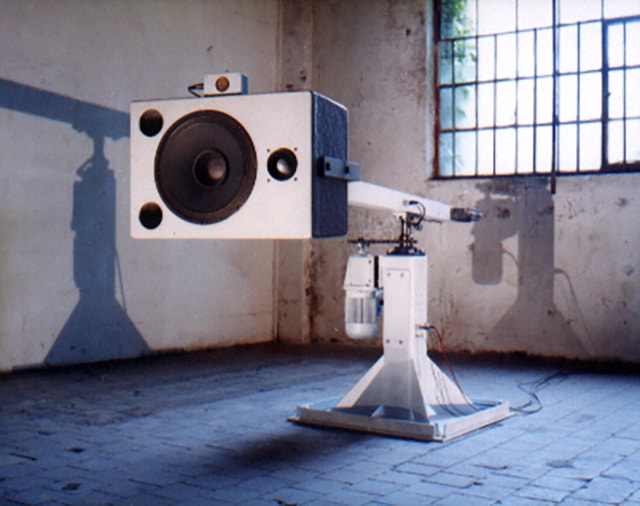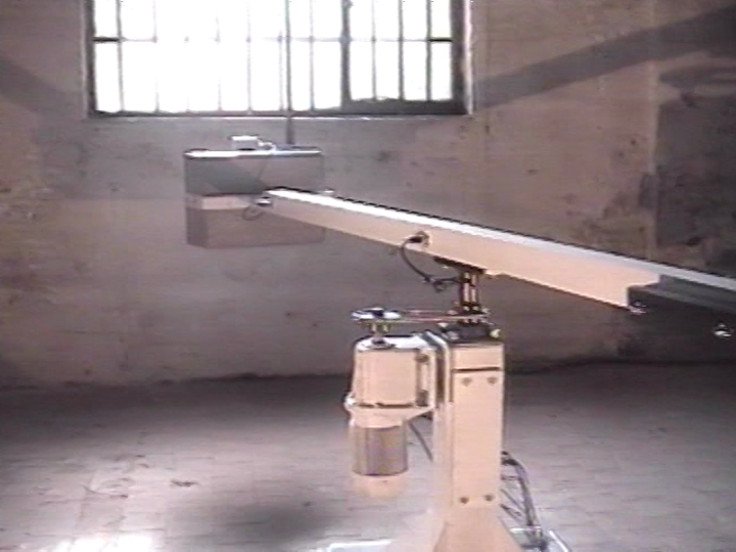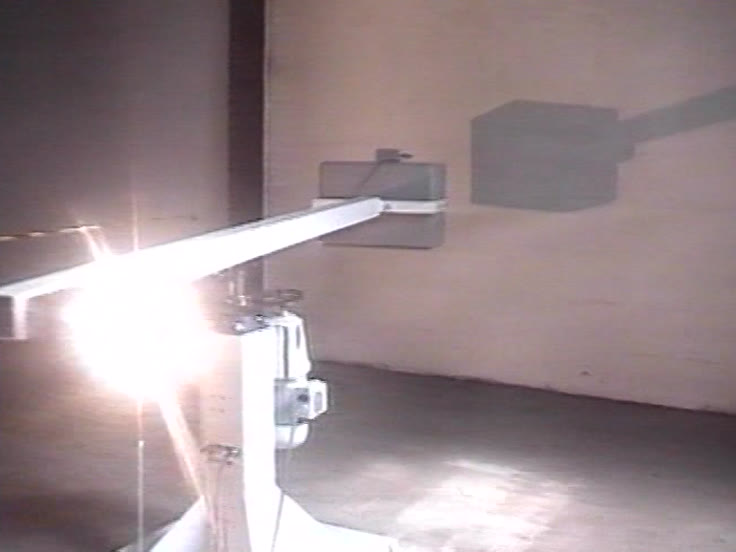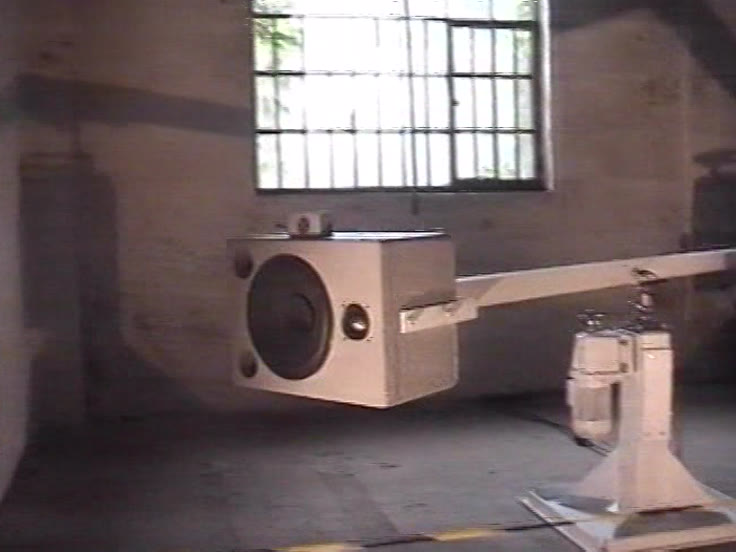title
Spatial Sounds (100dB at 100km/h)
artist
Marnix de Nijs and Edwin van der Heide
intro
Spatial Sounds (100dB at 100km/h) is an interactive audio installation created by artists Marnix De Nijs and Edwin van der Heide. The installation, comprised of a speaker mounted onto a rotating arm that is several meters long, scans the surrounding space for visitors and reacts to their presence.
The speaker produces short, loud pulses, and ‘listens’ to the reverberations from the empty space. As the number of visitors increases, their movement manipulates the sounds of the installation and determines the speaker’s motion, sounds, and speed.
As the activity increases in the installation space, the speaker begins to spin faster, up to speeds of 100km/h, creating a game of attraction and repulsion between human and machine. The work questions the present-day role of the machine, asking whether we control machines or machines control us.
biography artist
Edwin van der Heide (1970, Hilversum, The Netherlands) is an artist, composer and performer. The central theme of his work is the interaction of sound and space. In 1992, he graduated from the Institute of Sonology at the Royal Conservatory in The Hague and in 1993 he co-founded the group Sensorband with Zbigniew Karkowski and Atau Tanaka. His current work is hard to define within the traditional terminology of music, sound art, or media art, as he is always working at the edge of his medium. Edwin teaches part-time at the Interfaculty Sound & Image at the Royal Conservatory and Royal Academy of Art in The Hague, and has guest-lectured, performed, and shown installations extensively in the Netherlands and abroad.
Marnix de Nijs is a Dutch installation artist and considered a pioneer of Dutch media art since the mid 90s. He makes use of high-concept mechanics, software, and ever-evolving technologies to create interactive artworks that play with the viewer’s perception of image, sound, and movement. De Nijs’ work explores how contemporary technological culture acts upon our senses and continuously shapes our modes of perception. To create his technologically complex installations, de Nijs often relies on close collaborations with media labs, universities, and highly skilled developers/engineers. De Nijs’ work has been widely exhibited at international art institutes, museums and festivals. In 2005, he collected the prestigious Witteveen & Bos Art and Technology Prize, for his entire oeuvre.
keywords
speaker, sound, sensor, robot art, robotics, interactive, installation, technology, society
images
[caption id="attachment_407" align="alignnone" width="640"] Marnix de Nijs en Edwin van der Heide, Spatial Sounds, 2000. Photo: Rob 't Hart.[/caption]
[caption id="attachment_1029" align="alignnone" width="736"]
Marnix de Nijs en Edwin van der Heide, Spatial Sounds, 2000. Photo: Rob 't Hart.[/caption]
[caption id="attachment_1029" align="alignnone" width="736"] Marnix de Nijs en Edwin van der Heide, Spatial Sounds, 2000.[/caption]
[caption id="attachment_1030" align="alignnone" width="736"]
Marnix de Nijs en Edwin van der Heide, Spatial Sounds, 2000.[/caption]
[caption id="attachment_1030" align="alignnone" width="736"] Marnix de Nijs en Edwin van der Heide, Spatial Sounds, 2000.[/caption]
[caption id="attachment_1030" align="alignnone" width="736"]
Marnix de Nijs en Edwin van der Heide, Spatial Sounds, 2000.[/caption]
[caption id="attachment_1030" align="alignnone" width="736"] Marnix de Nijs en Edwin van der Heide, Spatial Sounds, 2000.[/caption]
Marnix de Nijs en Edwin van der Heide, Spatial Sounds, 2000.[/caption]
 Marnix de Nijs en Edwin van der Heide, Spatial Sounds, 2000. Photo: Rob 't Hart.[/caption]
[caption id="attachment_1029" align="alignnone" width="736"]
Marnix de Nijs en Edwin van der Heide, Spatial Sounds, 2000. Photo: Rob 't Hart.[/caption]
[caption id="attachment_1029" align="alignnone" width="736"] Marnix de Nijs en Edwin van der Heide, Spatial Sounds, 2000.[/caption]
[caption id="attachment_1030" align="alignnone" width="736"]
Marnix de Nijs en Edwin van der Heide, Spatial Sounds, 2000.[/caption]
[caption id="attachment_1030" align="alignnone" width="736"] Marnix de Nijs en Edwin van der Heide, Spatial Sounds, 2000.[/caption]
[caption id="attachment_1030" align="alignnone" width="736"]
Marnix de Nijs en Edwin van der Heide, Spatial Sounds, 2000.[/caption]
[caption id="attachment_1030" align="alignnone" width="736"] Marnix de Nijs en Edwin van der Heide, Spatial Sounds, 2000.[/caption]
Marnix de Nijs en Edwin van der Heide, Spatial Sounds, 2000.[/caption]
year
2000
premiere
From documentation, it is unclear where the piece was first premiered. It did win the following prizes:
1st prize, Art Future media art competition, Taipei, Taiwan, 2000
Honorary mention, interactive art, Ars Electronica Festival, Linz Austria, 2001
Honorary mention Transmediale, Berlin, 2001
Honorary mention, Vida 5.0 Artificial Life International Competition, Madrid 2002
software
Self developed interaction software created within MAX/MSP
functionality
Spatial Sounds (100dB at 100km/h) is an interactive work that needs to be experienced in a social context. Visitors to the exhibition space simultaneously interact with the installation and with one another. The sensors on the installation scan both the audience and the objects in the space as the speaker is spinning, creating a spatial description that is similar to a traditional radar map. When the installation scans the space, it makes inspecting movements and generates sounds that symbolize this scanning process. The sounds directly relate to both the position of the arm and the dynamic 'map' of the space and the visitors. Different locations in the space represent different sounds, as does the distance of the visitors to the rotating arm. When visitors are present in the space, the installation alternates between three different interaction modes: giving a single visitor control, group interaction, and the machine controlling the visitors.
The interaction between the audience and the installation is continuously changing, depending on how many people are in the space and their level of movement and activity. The more the audience engages and plays with the installation, the more active it becomes.
part of collection
The work is part of the V2_Agency media catalogue1
production
The concept and realization of the work was done by Marnix de Nijs and Edwin van der Heide. Construction assistance was provided by Tom van der Stelt.
hardware
Robotic arm
Speaker
Macintosh computer
Polaroid ultrasonic distance measurement sensor
Biphase angle measurement sensor
Triphase motor-controller
MIDI to voltage converter
Lightdesk
Stroboscope
technical specs
The sound and movements of Spatial Sounds (100dB at 100km/h) are generated in real-time. Although the algorithms are precisely defined, the sound that is generated depends on the visitors’ interaction with the installation. There is a sonar sensor on top of the speaker, which measures the distances of visitors and objects in relation to the speaker. There is also a biphase angle sensor mounted on the axis of the installation, which outputs the current position of the arm in steps of 3 degrees. The data from both sensors are transmitted, via MIDI, to the computer that generates the sound in real-time using custom software. The software also controls a light desk to change the light settings and incidentally switch on a stroboscope. The maximum speed of the speaker is 100 km/h.
This PDF has the full spatial and technical set-up of the piece: archive.aec.at (pdf).
intention artistquote by artist
quote
“In our daily lives we are using many machines and tools. Some of them function mechanically and others are a hybrid of a physical interface and a computer controlled virtual process. In most situations we believe that we control a machine and accidentally there are moments where we lose the control over it. The installation Spatial Sounds (100dB at 100km/h), developed by Marnix de Nijs and Edwin van der Heide, is focusing on the topic of control and taking it one step further. It is an attempt to make a machine that includes the ability to control people. When we define a robot as an independent machine with its own behavior it is important that the robot not only follows instructions from people but also surprises them. Such a moment of surprise is a moment where the robot is initiating the communication and therefore in control of the situation. It is this context that makes Spatial Sounds (100dB at 100km/h) an interesting installation to study from the perspective of human robot personal relationships.”2
influence
Artist and musician Will Schrimshaw writes about the influence that Spatial Sounds had on his own work, Spatial Silences.3
context
LITERATURE
Broeckmann, Andreas. “Deep Screen - Art in Digital Culture. An Introduction.” Virose, June 2008, virose.pt.
Cerpina, Zane. “Art of Fear: Marnix De Nijs.” Experimental Emerging Art, 9 Mar. 2018, eejournal.no.
Leopoldseder, Hannes, and Schöpf Christine, editors. “Cyberarts 2001: International Compendium Prix ARS Electronica.” Cyberarts 2001: International Compendium Prix ARS Electronica, Springer, 2001, pp. 114–115.
Mulder, Arjen. From Image to Interaction: Meaning and Agency in the Arts, V2_Publishing/Nai Publishers, 2010.
“Spatial Sounds - Encountering Control Society at 100km/h Speed & 100dB Loudness.” [KONTEJNER], stari.kontejner.org.
Van der Heide, Edwin. “Spatial Sounds (100dB at 100km/h) in the Context of Human Robot Personal Relationships.” Human-Robot Personal Relationships: Third International Conference, HRPR 2010, Leiden, the Netherlands, June 23-24, 2010, Revised Selected Papers, edited by Maarten H. Lamers and Fons J. Verbeek, Springer, 2011, pp. 27–33.
part of active discussion
scene artists institutes
V2_ , V2_Agency, Institute of Sonology at the Royal Conservatory in The Hague
footnote
1 “Agency.” V2_Institute For the Unstable Media, 23 Jan. 2015, v2.nl/agency.
2 Edwin van der Heide, “Spatial Sounds (100dB at 100km/h) in the Context of Human Robot Personal Relationships.” Lecture Notes of the Institute for Computer Sciences, Social Informatics and Telecommunications Engineering Human-Robot Personal Relationships, 2011, pp. 27–33.
3 Will Schrimshaw, “Movement, Affect, Intensity: Bodies and Populations in Interactive Sound Art.” 31 Aug 2006, citeseerx.ist.psu.edu (pdf).
Annie Abrahams
Livinus van de Bundt & Jeep van de Bundt
Driessens & Verstappen (Erwin Driessens and Maria Verstappen)
Yvonne le Grand
Edward Ihnatowicz
JODI (Joan Heemskerk & Dirk Paesmans)
Bas van Koolwijk
Lancel/Maat (Karen Lancel and Hermen Maat)
Jan Robert Leegte
Peter Luining
Martine Neddam
Marnix de Nijs and Edwin van der Heide
Dick Raaijmakers
Joost Rekveld
Remko Scha
Jeffrey Shaw
Debra Solomon
Steina
Peter Struycken
Michel Waisvisz